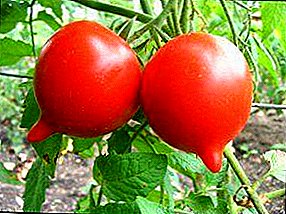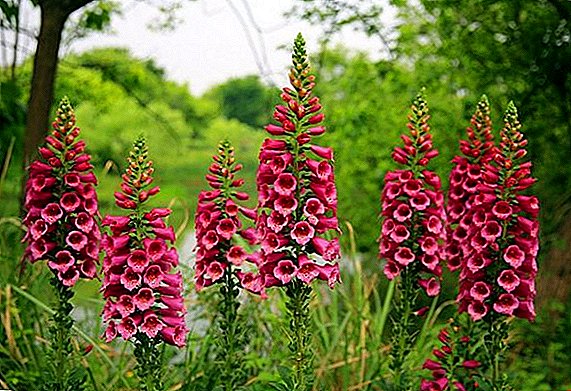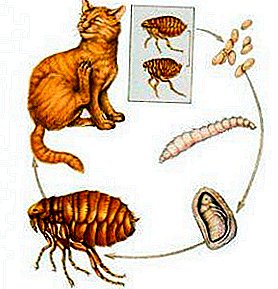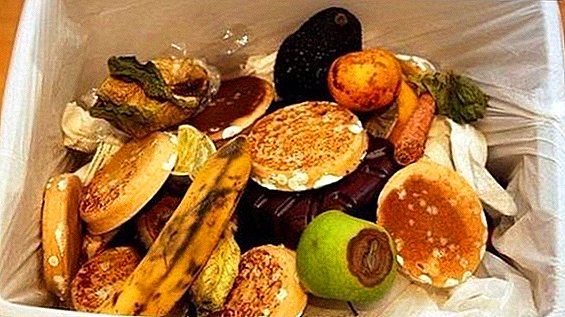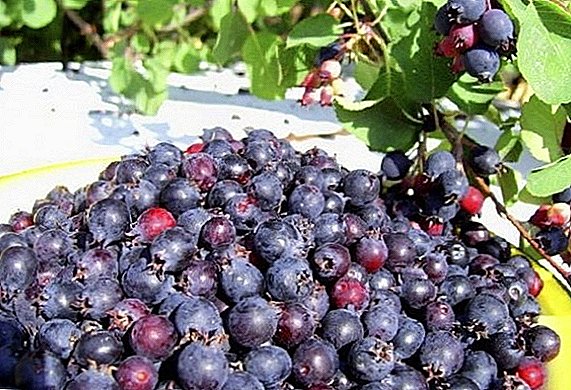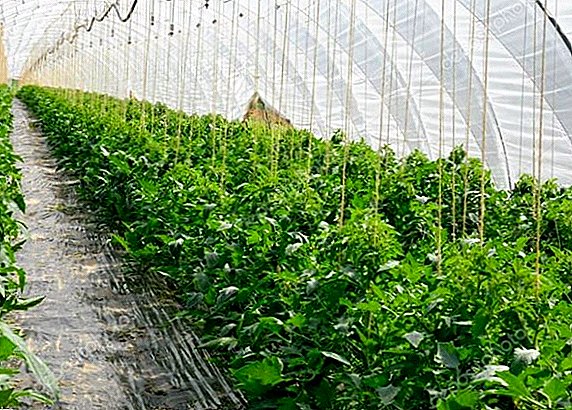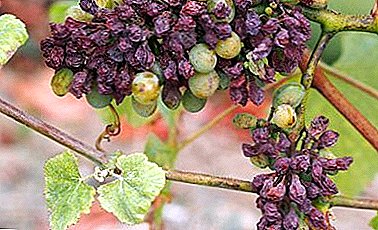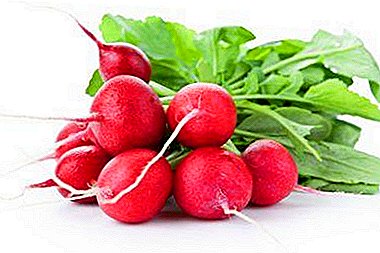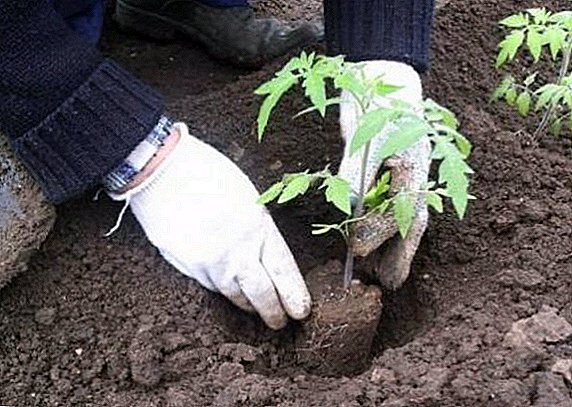 Planting greenhouse seedlings in the open ground is always an exciting event. A plant that has grown beautifully and developed in boxing indoors now has to face temperature fluctuations, the possibility of infection with diseases and parasites. Even for hardened seedlings, transplanting into open ground is a great stress, and therefore, in order to minimize it, you need to follow a few simple rules.
Planting greenhouse seedlings in the open ground is always an exciting event. A plant that has grown beautifully and developed in boxing indoors now has to face temperature fluctuations, the possibility of infection with diseases and parasites. Even for hardened seedlings, transplanting into open ground is a great stress, and therefore, in order to minimize it, you need to follow a few simple rules.
When to plant seedlings of tomatoes
Tomato seedlings planted in open ground in early MayThe next stage is transplanting saplings under film cover (May 15 - 25). You can remove the film after establishing a stable good weather and high air temperature. For different varieties of tomatoes, the dates may vary slightly, but not more than 14 days.
Check out the list of varieties of tomatoes for cultivation in the open field: "Bull's heart", "Pink honey", "Budenovka", "Yamal", "Tretyakovsky", "Shuttle", "Black Prince", "Dubrava", "Batyana", "Liana", "Pertsevidny", "Kate", "Newbie", "Gina".
The appearance of seedlings
Before planting tomatoes in open ground, seedlings must gain enough strength and adapt to the climatic conditions in which the growing season will continue. About the readiness of seedlings can be judged by the length of the stem and the number of these leaves. By the time of transfer to open ground the stem should be 25-30 cm in length and have 6-7 true leaves, as well as one flower brush, but the flower brush does not always appear.

Depending on the climate
More sustainable seedlings can be planted in the tenth of May, but such decisions are necessary, given the climatic features of the growing region. If in the corresponding region there is a tendency to frosts in the middle or beginning of May, then it is better to wait until the twenties or even the thirties.
Moon calendar
The lunar cycle lasts 29.5 days, hence the inconsistencies with the generally accepted calendar and recommendations about the transplanting. All of them are based on the statement that different phases of the moon have different effects on the environment and on plant growth as well. It is believed that during the new moon, the full moon, the first and last quarters of the moon, the sun and the moon interact with each other in a special way, which is negatively displayed on all matters initiated during this period.
The phase of the growing (young) Moon is considered to be a favorable time for planting and for other undertakings in general. The young moon - the phase following the new moon, takes a total of 11 days in a month, alternating and interrupting other phases. For example, The lunar calendar for May 2017 looks like this:
- 1-4.05.17 - the moon is growing;
- May 6-11, 17 - the Moon is growing;
- 13-19.05.17 - the waning moon;
- May 21-27: 17 - the waning moon;
- 29-31.05.17 - the growing Moon (new, young).
That is, if you decide to plant your garden, guided by the lunar calendar, you have to consider two factors: the phase of the moon and in which of the signs of the zodiac it is. Fertile signs are Libra, Taurus, Capricorn, Pisces, Cancer and Scorpio, and Aries, Virgo, Gemini and Leo are barren.
Did you know? The largest number of tomatoes is grown in China - about 16% of the world crop.
Transplanting
When you are going to plant tomatoes in open ground, make sure that the seedlings undergo appropriate training. 2-3 weeks before disembarking, reduce the amount of incoming moisture and gradually reduce the temperature. For a start, the temperature is lowered by 3-5 degrees and improves the air circulation in the room. 5-7 days before planting, watering is stopped altogether.
Reducing watering helps to keep under control the growth of seedlings, which, with an abundance of moisture, can easily reach a meter in height before planting. In addition, the lack of moisture provokes its increased absorption and a strong push for the growing season, when the plant eventually receives it. But be careful: yellowed leaves or stems that have partially lost turgor indicate that seedlings suffer from an acute moisture deficit and need a "sip of water."
Important! Tomatoes are very well perceived organic fertilizer, but for this purpose, in no case can not use fresh manure, as an excess of nitrogen can harm the plant and make it unstable to various diseases.

Weather
Ideally, if it was raining before the landing day and the earth was wet enough, but we couldn’t create suitable weather conditions, we would start from the calendar dates. To begin planting tomatoes in open ground should be after about 17:00, when solar activity began to decline. Tomatoes need time for rooting and the extra 24 hours before the next sun is a good odds.
If the seedlings are planted in the morning, the seedlings may wither, as the root system damaged during transplantation will not have time to recover and will not be able to absorb moisture from the soil for some time. Speaking of soil temperature, it should be warm enough. To do this, the air temperature must stay above 17 ° for at least seven days.
Landing place
Tomatoes are very heat-loving plantsTherefore, when choosing a place for their landing, the sun access criteria should be one of the leading ones. The soil on which tomatoes will grow should be loose and fertile.
The ideal option would be black, but good yields can be collected from peaty soils. Clay and loamy soils are not suitable at all, sandy soils pass air well, but need generous annual fertilizer.
Precursor cultures are also important. Good crop predecessors for tomatoes - cucumbers, turnips, onions, carrots, beets, cauliflower and, of course, green manure. Bad predecessors are other solanaceous, such as potatoes.

Annual cultivation in the same area of related crops causes the accumulation of common diseases and parasites that can persist in the soil in the form of spores or larvae. In the future, this situation can lead to significant difficulties in growing, and even to yield loss.
Landing pattern
As in many other aspects of planting and caring for crops, the planting of tomatoes is a thoughtful process, in which there are no random or arbitrary components. Distance between rows, bushes and hole depth depends on growing region, varieties of tomatoes and the size of seedlings at the time of planting. In regions with high humidity, the distance between seedlings should be greater than in arid ones.
Did you know? Pink tomatoes are similar to chocolate in their effects on the nervous system, as they contain large amounts of serotonin.
More space contributes to better ventilation and better sunlight. Good access of air and heat is the best prevention of fungal diseases such as powdery mildew or root rot. This scheme is used mainly in the forest-steppe zone.
In arid regions, on the other hand, bushes are located as close to each other as possible to prevent the soil from drying out and retain more moisture. The scheme is suitable for steppe and forest-steppe zones. The landing pattern depends on the height of the seedlings. It is logical that the larger the plant, the more space it will need.

Here are some proportions for tall, medium and short growing tomatoes:
- Tall varieties. The height of the bush is more than 150 cm. It is planted at a distance of 80-100 / 50-60 cm, where 80-100 is the distance between the rows, and 50-60 is the distance between the bushes.
- Sredneroslye varieties. The height of the bush is less than 150 cm (100 cm on average). Planted at a distance of 70-80 / 45-50 cm.
- Low-growing varieties. The height of the bush is from 30 to 100 cm. They are planted at the rate of 60-70 cm - between the rows, 20-40 cm - between the bushes.
- Dwarf varieties. Very small tomatoes, the height of the bush does not exceed 30-40 cm. They are planted in a special well-hole system. In the case of a well-hole method, 2 bushes are placed in one hole at a distance of about 10 cm. They are kept 50 cm between the rows, and 30 cm between the holes.
When growing tomatoes, you need to feed them, water them, look in steps and get rid of weeds in time. And you can also mulch that will help retain moisture and prevent weeds from growing.
Technology
Compliance with the conditions for planting tomatoes in open ground will require considerable effort from the farmer. This is a complex process with many components and requiring special equipment, but the methods undertaken will provide a good result.

The technology of growing tomatoes includes the following elements:
- Soil preparation. Includes cleaning of residues of the precursor, surface peeling for provoking the growth of weed seeds. And finally, deep plowing (2-3 weeks after peeling).
- Fertilizer. Fertilize the soil twice: the first time during deep plowing, the second time - directly during the transplanting. Frontal fertilizer can be organic or mineral, and semi-fertilizer - only organic. Before lowering the seedling in the hole, a small amount of humus or other fertilizer for tomatoes is placed at the bottom of the recess, then a layer of soil follows, and then the plant is planted in the hole.
- Transplanting. In the absence of transplanting machines, seedlings are planted in the digged holes. The depth of the holes depends on the size of the bush, in addition, you need to take into account that the fertilizer that you will throw in the holes will also take up some space. Unless it was raining the day before, each plant needs additional watering during planting. The process itself looks like this: the sapling must be lowered into the hole, holding it by the top. Then, without releasing the plant, start pouring water into the hole and gently press it with damp earth. This method greatly helps the rooting process.
- Care. After 2 weeks it is worth doing the first weeding and at the same time loosen the ground. The following weeding should be carried out as necessary. Watering is also carried out as needed, the only period when tomatoes need a lot of moisture is the ovary and fruit ripening.
- Cleaning. Since about ten fruits are tied on a bush at different times, they should also be collected at intervals of several days (3-5).
Simple recommendations will help you to collect a great harvest, enjoy yourself and delight your friends and loved ones. Armed with knowledge of several key points, you will certainly succeed in your endeavors. Good luck!



